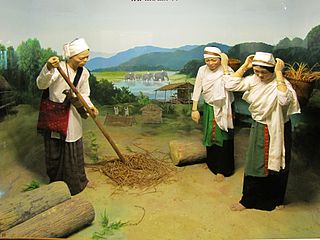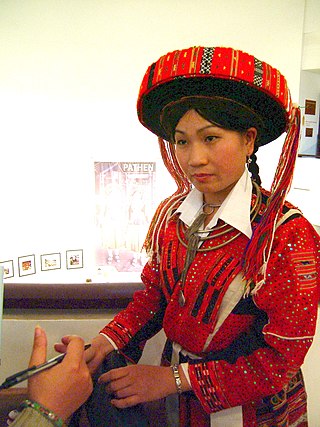
Lhoba is any of a diverse amalgamation of Sino-Tibetan-speaking tribespeople living in and around Pemako, a region in southeastern Tibet including Mainling, Medog and Zayü counties of Nyingchi and Lhünzê County of Shannan, Tibet.

Arunachal Pradesh is a state in northeast India. It was formed from the North-East Frontier Agency (NEFA) region, and India declared it as a state on 20 February 1987. Itanagar is its capital and largest town. It borders the Indian states of Assam and Nagaland to the south. It shares international borders with Bhutan in the west, Myanmar in the east, and a disputed 1,129 km border with China's Tibet Autonomous Region in the north at the McMahon Line. Arunachal Pradesh is claimed in its entirety by China as South Tibet as part of the Tibet Autonomous Region; China occupied some regions of Arunachal Pradesh in 1962 but later withdrew its forces.

The Akha are an ethnic group who live in small villages at higher elevations in the mountains of Thailand, Myanmar, Laos and Yunnan Province in China. They made their way from China into Southeast Asia during the early 20th century. Civil war in Burma and Laos resulted in an increased flow of Akha immigrants and there are now 80,000 people living in Thailand's northern provinces of Chiang Rai and Chiang Mai.

Nyishi community is the largest ethnic group in Arunachal Pradesh in north-eastern India. The Nyishi language belongs to the Sino-Tibetan family, however, the origin is disputed. Their population of around 300,000 makes them the most populous tribe of Arunachal Pradesh, closely followed by the tribes of the Adi according to 2001 census.

The Apatani people are an ethnic group who live in the Ziro valley of Arunachal Pradesh's Lower Subansiri region.

The Tagbanwa people are an indigenous people and one of the oldest ethnic groups in the Philippines, mainly found in central and northern Palawan. Research has shown that the Tagbanwa are possible descendants of the Tabon Man, thus making them one of the original inhabitants of the Philippines. They are a brown-skinned, slim, and straight-haired ethnic group.

The Tai Khamti, also known as the Hkamti Shan or simply as Khamti, are a Tai ethnic group of India, China and Myanmar. The Tai-Khamti are followers of Theravada Buddhism. The Tai-Khamti have their own script for their language, known as 'Lik Tai', which originated from the Shan (Tai) script of Myanmar. Their mother tongue is known as Khamti language. It is a Tai language, closely related to Thai and Lao.
Abotani or Abu Tani is considered the progenitor of the Tani tribes of the state of Arunachal Pradesh in India. Abotani are located in Tibet and Arunachal Pradesh. In China, Abotani tribes recognized as part of Lhoba ethnic group. The Apatani, Nyishi, Adi, Galos, Tagin and Mising are the Subtribes of Abotanis. They follow the Donyi-Polo religion and credit Abotani with the technique of rice cultivation.

The Tagins are one of the major tribes of Arunachal Pradesh, India, a member of the larger designation of Tani Tribes. The Tagins refers to a tribe of Northeast India Region. The Tagins are members of the larger designation of Abotani. Most Tagin are adherents of Donyi-Polo, with a Christian minority.

The Tani people include the Adi, Apatani, Galo, Mising, Nyishi, and Tagin ethnic groups of India and China. As members of the Sino-Tibetan ethnic group, they speak various Tani languages and primarily reside in the Indian states of Arunachal Pradesh and Assam, as well as the Tibet Autonomous Region in China.

Kaamatan or Pesta Kaamatan is a form of harvest festival celebrated on 30 and 31 of May annually in the state of Sabah and Federal Territory of Labuan in Malaysia.

The Ifugao people are the ethnic group inhabiting Ifugao province in the Philippines. They reside in the municipalities of Lagawe, Aguinaldo, Alfonso Lista, Asipulo, Banaue, Hingyon, Hungduan, Kiangan, Lamut, Mayoyao, and Tinoc. The province is one of the smallest provinces in the Philippines with an area of only 251,778 hectares, or about 0.8% of the total Philippine land area. As of 1995, the population of the Ifugaos was counted to be 131,635. Although the majority of them are still in Ifugao province, some of them have moved to Baguio, where they work as woodcarvers, and to other parts of the Cordillera Region.

The Pà Thẻn are Pa-Hng-speaking people classified as an ethnic group of Vietnam. Most Pà Thẻn live in Hà Giang and Tuyên Quang provinces, located in Vietnam's Northeast region. Their Pa-Hng language belongs to the Hmong–Mien language family.
The Apatanis who inhabit a tranquil pine clad valley called Ziro at the core of Lower Subansiri District of Arunachal Pradesh, are famous for their unique practice of wet rice cultivation. They are also known for their sustainable agricultural practices and the agricultural cycles govern their everyday lives. The agricultural festival of Dree is the highlight in this cycle.

The 'Mopin' or 'Moopin' Festival is an agricultural festival celebrated by the Galo tribe of Arunachal Pradesh, India in particular of the Galo group of tribes which resides in East Siang and West Siang districts. It is a celebration of the harvesting season held in the Galo months of "Lumi" and "Luki", corresponding to March–April and the new year for the Galo tribe. The Galo tribe follow an animist religion called Donyi-Polo.
Nyokum is a festival celebrated by the Nyishi tribe of the Indian state of Arunachal Pradesh. The Word Nyokum has been derived from the combination of two words - Nyok means land (earth) and Kum means collectiveness or togetherness. Therefore, the Nyokum festival may very well be interpreted as inviting all the Gods and Goddesses of the universe, with the Nyokum Goddess as the principal deity, to a particular venue at a particular time. The festival is commonly celebrated by the people from all class and walk of life for better productivity, prosperity and happiness of all human beings.

The Kankanaey people are an indigenous peoples of northern Luzon, Philippines. They are part of the collective group of indigenous peoples in the Cordillera known as the Igorot people.

The Mising people are a Sino-Tibetan ethnic group inhabiting mostly in the Northeast Indian states of Assam and Arunachal Pradesh. They are part of the greater Tani group of people of India and Tibet Autonomous Region of China.

Kev Dab Kev Qhuas is the common ethnic religion of the Miao people, best translated as the "practice of spirituality". The religion is also called Hmongism by a Hmong American church established in 2012 to organize it among Hmong people in the United States.

Apo, apong, or poka is an alcohol drink commonly found among the Tani tribes in the Northeast India states of Arunachal Pradesh and Assam. It is prepared by fermentation of rice. It is known by various names across different tribes in Arunachal Pradesh and Assam.

















